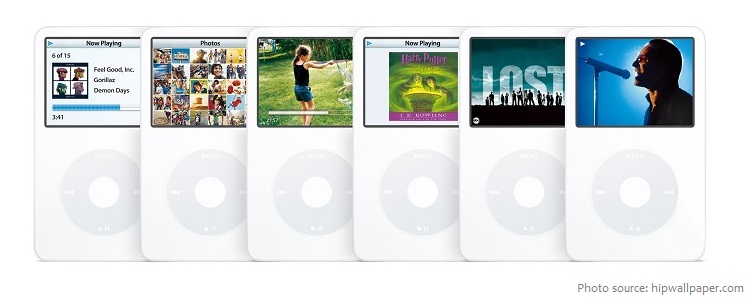
The iPod is a range of portable music players designed by the company Apple Inc.
Apple’s chief executive officer, Steven Jobs, who recognized potential in the nascent personal media player market, commissioned Apple engineer Jon Rubinstein to create a product in keeping with Apple’s minimalist, user-friendly style.
On October 23, 2001, Apple Computers publicly introduced the iPod.
Created under project codename Dulcimer, the iPod was announced several months after the release of iTunes, a program that converted audio CDs into compressed digital audio files and allowed users to organize their digital music collection.

The first song played using iTunes, was a house-music dance tune called “Groovejet (If This Ain’t Love).”
The success of the iTunes Store allowed Apple to become one of the leading retailers of music in the United States.
The name “iPod” was proposed by Vinnie Chieco, a freelance copywriter, who was called by Apple to figure out how to introduce the new player to the public. After Chieco saw a prototype, he thought of the movie 2001:
A Space Odyssey and the phrase “Open the pod bay doors, Hal”, which refers to the white EVA Pods of the Discovery One spaceship. Chieco saw an analogy to the relationship between the spaceship and the smaller independent pods in the relationship between a personal computer and the music player.

The original iPod model contained a version of the bat-n ball game Breakout entitled Brick. It was included as an Easter egg and the only way to access the game was to visit the About menu and hold down Select for
five seconds. In subsequent models, Brick was added to the Extras menu. It was fitting that Brick should be the first iPod game as Apple founders Steve Jobs and Steve Wozniak were involved with the design of the original Breakout arcade game in 1976.
As development progressed, Apple continued to refine the software’s look and feel, rewriting much of the code. Starting with the iPod Mini, the Chicago font was replaced with Espy Sans. Later iPods switched fonts
again to Podium Sans—a font similar to Apple’s corporate font, Myriad. Color display iPods then adopted some Mac OS X themes like Aqua progress bars, and brushed metal meant to evoke a combination lock.

In 2007, Apple modified the iPod interface again with the introduction of the sixth-generation iPod Classic and third-generation iPod Nano by changing the font to Helvetica and, in most cases, splitting the screen
in half by displaying the menus on the left and album artwork, photos, or videos on the right (whichever was appropriate for the selected item).
In 2006 Apple presented a special edition for iPod 5G of Irish rock band U2. Like its predecessor, this iPod has the signatures of the four members of the band engraved on its back, but this one was the first time the company changed the color of the metal (not silver but black). This iPod was only available with 30 GB of storage capacity. The special edition entitled purchasers to an exclusive video with 33 minutes of interviews and performance by U2, downloadable from the iTunes Store.

The smallest mp3 player is the iPod shuffle, introduced on 11 March 2009 by Apple. It measures just 29 x 31.6 x 8.7 mm (1.14 x 1.24 x 0.34 in) and weighs 12.5 grams (0.44 oz). The iPod shuffle holds up to 1,000 songs and has all of the controls located on the earphone cord.
In mid-2015, several new color schemes for all of the current iPod models were spotted in the latest version of iTunes, 12.2. Belgian website Belgium iPhone originally found the images when plugging in an iPod for the first time, and subsequent leaked photos were found by Pierre Dandumont.
On July 27, 2017, Apple removed the iPod Nano and Shuffle from its stores, marking the end of Apple producing standalone music players. Currently, the iPod Touch is the only iPod produced by Apple.
Many accessories have been made for the iPod line. A large number are made by third-party companies, although many, such as the iPod Hi-Fi, are made by Apple. Some accessories add extra features that other music players have, such as sound recorders, FM radio tuners, wired remote controls, and audio/visual cables for TV connections. Other accessories offer unique features like the Nike+iPod pedometer and the iPod Camera Connector.
Video games are playable on various versions of iPods.
